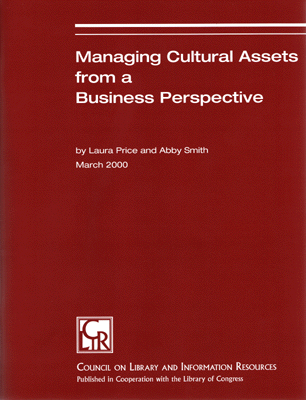Managing Cultural Assets from a Business Perspective

by Laura Price and Abby Smith
March 2000
Published in Cooperation with the Library of Congress
![]()
Copyright 2000 by the Council on Library and Information Resources. No part of this publication may be reproduced or transcribed in any form without permission of the publisher. Requests for reproduction should be submitted to the Director of Communications at the Council on Library and Information Resources.
- Origins of the Risk Assessment Model
- Defining Business Risk
- Creating an Internal Control Framework
- Identifying Relevant Controls
- Determining How to Assess Risk
- Conducting the Risk Assessment
- Addressing Unacceptable Risks
- Monitoring Risk: An Ongoing Process
- Limitations on Internal Control
Long-Term Benefits of Risk Assessment
- Integrating Technology
- Taking Preventive Action
Appendix I: The Business Risk Model
Figures and Tables
About the Authors
Laura Price is a senior manager in the Public Services-Assurance Practice of KPMG LLP in Washington D.C. Ms. Price provides audit and advisory services to Federal government clients in both the legislative and executive branches of the government. She worked closely with the Library of Congress in developing the business risk model described in this report.
Abby Smith is director of programs at the Council on Library and Information Resources (CLIR). Before joining CLIR in 1997, Ms. Smith was assistant to the associate librarian for library services at the Library of Congress. In this capacity, she worked with KPMG LLP to develop the business risk model.
Preface
This report describes how the Library of Congress developed and implemented a plan for greater accountability over its collections. It is, in one sense, a case study. However, although the details of this study are unique to a single institution, the report sets out a model that can easily be adapted to every type of library, no matter how small, how specialized, or how atypical. The Library of Congress found itself in the awkward, if familiar, position of answering such questions from its oversight body as “How much are your collections worth?” “How do you determine how much to invest in security (or cataloging, or preservation, or collection development)?” and “What if you digitize your collections?” The business risk model described in this report was designed to help Library management answer these questions.
The role of collections and the funding it takes to make them productive are being called into question these days for several reasons. First, libraries no longer must have physical custody of an item-own it, in other words-to serve it to a patron. With the growth of interlibrary lending and the spread of networked resources, libraries have begun to uncouple collections and services. This development coincides with the increasing demand by funding organizations to manage library services and collections in a businesslike way. This notion is just as strange to libraries as was the notion of virtual collections 20 years ago.
Given how little data we have about the relationship between access to collections and the productivity of scholars, the achievements of students, or the general enlightenment of the public who use library resources, many managers are rightly concerned about treating the library business as a business. Nonetheless, it is not difficult to translate the work that goes on in libraries into the language of business. Nor is it incorrect to assess the effectiveness of libraries by investigating how responsibly staff members meet their obligations as custodians of collections. Responsible stewardship is at the heart of professional librarianship, and such stewardship is the focus of this report.
This report proposes a model that addresses the major challenges facing library managers, funders, and staff. Based on business risk assessment, the model defines library collections as core institutional assets and sets forth a model for accountability over those assets. It widens the definition of who is involved in the stewardship of library assets. Its aim is to guide managers in identifying both risk to collections and strategic investments in the productivity of institutional assets.
This report was developed with the cooperation of the Library of Congress through a partnership between the Council on Library and Information Resources (CLIR) and KPMG LLP, an international audit and business advisory firm. The Public Services-Assurance Practice of KPMG LLP developed the business risk model for the Library of Congress and coauthored this report with CLIR.
Abby Smith
Director of Programs

